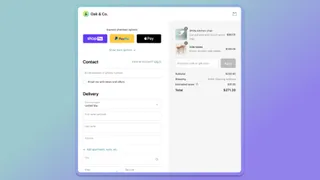eCommerce: What it all means, and how to sell online yourself
Hundreds of years ago, if you had something to sell, you only had the local marketplace to make your money. In the present day, the entire world can be your marketplace with a brief understanding of eCommerce.
What is eCommerce?

It might sound intimidating, but eCommerce is simply the act of buying or selling goods over the internet.
Given the saturation of internet access across desktop and mobile devices, you can pretty much engage in eCommerce anywhere there’s a connection.
That might sound challenging, because there’s a lot to think about, from setting up a website to deciding how you want to sell online, to managing your inventory and shipping – it’s a lot, right?
It sounds challenging but it doesn’t have to be, with tools from platforms such as Shopify, ready to take the grunt work out so you can get on with the actual eCommerce itself. Let’s examine how.
What ways can I sell online?

Online sales can follow traditional sales methods, whether that’s direct sales to consumers through a storefront, a single mention on social media, or an auction format. You can decide what’s the best fit for your business model!
Here’s some of the ways that you can consider selling goods and services online:
· Direct Business To Consumer (B2C): Your classic storefront, a business selling to consumers.
· Direct Business To Business (B2B): Do you have products that resonate more with businesses than singular consumers? You’re in the B2B space.
· Consumer to Consumer (C2C): Fairly similar to B2C, but in this case it encompasses selling goods you may have purchased yourself – so a second-hand laptop, for example.
· Dropshipping: A mix of B2C and B2B, you act as the intermediary between a larger wholesaler and individual consumers.
· Wholesale: Do you have access to bulk goods and need an efficient way to sell them? Wholesale selling is a great way to quickly sell considerable quantities of goods.
· Digital Product sales: Not everything sold online needs to be a physically deliverable product, whether you’re selling digital gift vouchers or digital artworks.
· Services: It’s not just products that can work within the eCommerce model, many services can be distributed online as well.
· Subscriptions: Whether you’re providing rolling services or access to goods on a continuous basis as they’re developed, a subscription model can be a solid way to earn long term, recurring revenue.
Where should I sell products or services online?

There’s a number of approaches to online sales and eCommerce that are worth exploring. Your approach should be dependent on what you’re selling and what potential customers you are looking to target.
These can include large already branded services, although in that space you’re competing with many other brands with established market share.
Plenty of online entrepreneurs make good money selling through social media. When selling through social media, it’s important to establish brand trust and balance the constantly shifting algorithms.
You can of course also set up your own website for selling your goods or services, which can significantly help to build out your eCommerce brand.
Looking to set up your own website but concerned about the technicalities of web hosting or coding up a website to incorporate secure online selling?, Shopify’s got your back with a range hosting, website building and eCommerce tools that can get an online shop up with ease.
Starting up your eCommerce business: What you must consider

What’s your business plan? While services such as Shopify can make setting up your online eCommerce business both easy and affordable, it’s best to have a properly laid out business plan written up beforehand. Planning upfront can help you avoid problems, move flexibly when business conditions change and more accurately track the growth of your eCommerce business over time.
First impressions are important: Without physical presence, how you sell your goods – both descriptive terms and photos can make a huge difference when you’re trying to close a sale. Shopify Magic AI can make it a breeze getting product descriptions that will entice customers while hitting SEO targets, as well as cleaning up and polishing your product photos with ease.
Do your solutions scale and can you adapt them?

Businesses change and adapt, especially online, so it’s vital to set up your eCommerce business with a provider that can grow as you do, as well as having a flexible set of tools for when and if your business changes.
With hundreds of apps to bring in tools for everything from online auctions to advanced analytics and templates galore to make your online eCommerce business, Shopify can help your business grow and adapt as and when you’re ready.
Security matters: Your customers will expect a secure shopfront, and you certainly wouldn’t want to have your own business accounts exposed either. Shopify provides industry-standard security across all of its eCommerce plans to help keep your data for your eyes only.
Shopify has a range of competitive monthly price points, starting as low as $42/month when paid yearly in advance, (or $56/month when paid monthly) for smaller shopfronts, and scaling upwards as your business expands rapidly and has significantly higher needs.
This gives you the room to let your business grow, secure in the knowledge that Shopify can scale up to meet your needs, including for point-of-sale transactions in the real world if you also require that kind of service.
Still not sure if Shopify is right for you? New Shopify users can enjoy the first three days free, then it’s just $1 per month for the first three months, which also includes your Shopify affiliate link. This lets you get to grips with the interface and start selling right away, with no ongoing commitment if your needs change. You’ve literally got nothing to lose – and plenty of customers and sales to gain.
#eCommerce #means #sell #online
